A Non-Contact Cow Estrus Monitoring Method Based on the Thermal Infrared Images of Cows
Abstract
:1. Introduction
2. Materials and Methods
2.1. Animals, Feed and Housing
2.2. Infrared Thermography Measurement
2.2.1. Acquisition Equipment
2.2.2. Capture Solutions
2.2.3. Thermal Infrared Image and Temperature Data Extraction
2.3. Ambient Temperature and Humidity Data Collection
2.4. Experimental Data Pre-Processing
2.4.1. Normalization Process
2.4.2. Thermal IR Image Correction
2.4.3. Thermal IR Image Feature Extraction
3. Construction of an Estrus Identification Method for Dairy Cows
3.1. Establishment of a Database of Thermal Infrared Temperatures of Cows in Heat
3.2. A LOGISTIC-Based Method for Identifying Cow Estrus Behavior
3.3. SVM-Based Method for Identifying Cow Estrus Behavior
3.4. Identification Method Evaluation Index
- (1)
- Error rate: this index describes the relationship between the number of false estrus warning samples FP and the number of detected estrus samples during estrus recognition in cows, and measures the occurrence of false alarms during estrus behavior recognition. The lower the error rate, the fewer false alarms are present in the estrus identification:
- (2)
- Recall: referred to as sensitivity in some of the estrous behavior recognition literature; this metric reflects the probability that the target category will not be reached. A higher recall rate indicates a better classification of the model:
3.5. Estrus Behavior Identification
4. Results and Discussion
4.1. Optimal Segmentation Profile of Dairy Cows’ Eyes and Vulvas
4.2. Body Temperature Change Pattern of Dairy Cows
4.3. Application of Thermal Infrared Technology in Estrus Monitoring
5. Conclusions
- (1)
- A feature extraction method of cows’ eyes and vulvas using lab-color-space-based thermal infrared imaging was proposed. The influence of different contours on the maximum temperature, minimum temperature and average temperature after a feature thermal infrared image segmentation was discussed, and the best segmentation contour for cows’ eye and vulva feature extraction was determined. The optimum eye segmentation contour was found to be r = 12, and the optimal vulva segmentation contour was found to be r = 12.5.
- (2)
- When the optimal segmentation contour was used, the detection rate of cow estrus behavior recognition based on the LOGISTIC model was 82.37%. This was lower than that of the SVM model in terms of the error rate and higher in terms of the recall rate. The method proposed in this paper has the advantages of a high sensitivity and accuracy. The non-contact device used to collect the thermal infrared images from cows can greatly reduce their stress response, which meets the needs of welfare breeding in actual cow production.
- (1)
- It is currently only applicable to small-scale farming situations due to the limitations of the thermal infrared image acquisition method.
- (2)
- We did not monitor the different stages throughout the entire estrous cycle.
Author Contributions
Funding
Institutional Review Board Statement
Data Availability Statement
Conflicts of Interest
References
- Wang, Z.; Zong, Z.Y.; Wang, H.J.; Yang, J.H.; Liu, G.Q.; Du, Y.J. Research status and development of digital detection methods for cow estrus. China Feed. 2021, 21, 134–138. [Google Scholar]
- Yang, J.X.; Jiao, H.C.; Sun, F.M.; Lin, H. Investigation and Analyswas on the Current Situation of Utilization of Dairy Cattle Breeding Facilities and Equipment in China. Chin. J. Anim. Sci. 2021, 57, 260–264. [Google Scholar]
- Pan, Y.Z.; Wang, H.; Xiong, B.H.; Jiang, L.S. Application of Estrus Monitoring System in Digital Management of Dairy Cows. Chin. J. Anim. Nutr. 2020, 32, 2500–2506. [Google Scholar]
- At-Taras, E.E.; Spahr, S.L. Detection and characterization of estrus in dairy cattle with an electronic heatmount detector and an electronic activity tag. J. Dairy Sci. 2001, 84, 792–798. [Google Scholar] [CrossRef]
- Yang, Y.Q. Oestrus identification in dairy cattle. Qinghai J. Anim. Husb. Vet. Med. 2007, 4, 65. [Google Scholar]
- Jiang, X.X.; Deng, S.Y.; Liu, W.; Wei, X.Y.; Ai, L. Identification Effects of Pedometer on Estrus of Holstein Cows during Peak Lactation Period. Anim. Husb. Feed Sci. 2014, 6, 63–65. [Google Scholar]
- Lvendahl, P.; Chagunda, M. On the use of physical activity monitoring for estrus detection in dairy cows. J. Dairy Sci. 2010, 93, 249–259. [Google Scholar] [CrossRef] [PubMed]
- Tan, Y.; He, D.J.; Guo, Y.Y.; Zhang, Z.R. Design and lmplementation of Real-time Monitoring System for Cow Estrus Based on Storm. J. Agric. Sci. Technol. 2018, 20, 83–90. [Google Scholar]
- Sakaguchi, M.; Fujiki, R.; Yabuuchi, K.; Takahashi, Y.; Aoki, M. Reliability of estrous detection in Holstein heifers using a radiotelemetric pedometer located on the neck or legs under different rearing conditions. J. Reprod. Dev. 2007, 53, 819. [Google Scholar] [CrossRef]
- Wang, H.; Zhao, X.F. Methods for estrus identification of high yield cows. Mod. Anim. Husb. 2009, 6, 22. [Google Scholar]
- Liu, Z.C.; He, D.J. Recognition Method of Cow Estrus Behavior Based on Convolutional Neural Network. Trans. Chin. Soc. Agric. Mach. 2019, 50, 186–193. [Google Scholar]
- Liu, Z.C.; Liu, Y.J. Design of wireless monitoring system for cow estrus crawling behavior based on Android. Heilongjiang J. Anim. Sci. Vet. Med. 2019, 15, 55–59 + 179. [Google Scholar]
- Zhang, Z.R. Research on detection of cow estrus information based on video analyswas. Northwest AF Univ. 2018. [Google Scholar]
- Geers, R.; Puers, R.; Goedseels, V.; Wouters, P. Electronic identification, monitoring and tracking of animals. CAB Int. 1997. [Google Scholar]
- Redden, K.D.; Kennedy, A.D.; Ingalls, J.R.; Gilson, T.L. Detection of estrus by radiotelemetric monitoring of vaginal and ear skin temperature and pedometer measurements of activity. J. Dairy Sci. 1993, 76, 713–721. [Google Scholar] [CrossRef] [PubMed]
- Kyle, B.L.; Kennedy, A.D.; Small, J.A. Measurement of vaginal temperature by radiotelemetry for the prediction of estrus in beef cows. Theriogenology 1998, 49, 1437–1449. [Google Scholar] [CrossRef] [PubMed]
- Timsit, E.S.; Assié; Quiniou, R.; Seegers, H.; Bareille, N. Early detection of bovine respiratory dwasease in young bulls using reticulo-rumen temperature boluses. Vet. J. 2011, 190, 136–140. [Google Scholar] [CrossRef]
- Lee, Y.; Bok, J.D.; Lee, H.J. Body temperature monitoring using subcutaneously implanted thermo -loggers from holstein steers. Asian-Australas. J. Anim. Sci. 2016, 29, 299–306. [Google Scholar] [CrossRef]
- Wataru, I.; Shuichi, I.; Dawasuke, K.; YuichiIto, J.T.; Michiko, T. Monitoring of the core body temperature of cows using implantable wireless thermometers. Comput. Electron. Agric. 2019, 163, 104849. [Google Scholar]
- Gundula, H.; Mariana, S.; Chrwastian, A.; Sandra, R.M.; Werner, B. Monitoring the body temperature of cows and calves using video recordings from an infrared thermography camera. Vet. Res. Commun. 2013, 37, 91–99. [Google Scholar]
- Talukder, S.; Kerrwask, K.L.; Ingenhoff, L. Infrared technology for estrus detection and as a predictor of time of ovulation in dairy cows in a pasture -based system. Theriogenology 2014, 81, 925–935. [Google Scholar] [CrossRef] [PubMed]
- Church, J.S.; Hegadoren, P.R.; Paetkau, M.J.; Partau, C.C.; Regev-Shoshani, G.; Schaefer, A.L.; Schwartzkopf-genswein, K.S. Influence of environmental factors on infrared eye temperature measurements in cattle. Res. Vet. Sci. 2014, 96, 220–226. [Google Scholar] [CrossRef] [PubMed]
- Uddin, J.; Mcneill, D.M.; Lwasle, A.T.; Phillips, C.J. A sampling strategy for the determination of infrared temperature of relevant external body surfaces of dairy cows. Int. J. Biometeorol. 2020, 64, 1–10. [Google Scholar] [CrossRef]
- Wang, X. Design and Implementation of temperature prediction detection platform for cows. Anhui Agric. Univ. 2020, 38, 212–225. [Google Scholar]
- Zhang, X. Study on diagnoswas method of heat stress in dairy cow based on infrared thermal imaging technology. Fujian Agric. For. Univ. 2016. [Google Scholar]
- Mota-Rojas, D.; Pereira, A.M.F.; Wang, D.; Martínez-Burnes, J.; Ghezzi, M.; Hernández-Avalos, I.; Lendez, P.; Mora-Medina, P.; Casas, A.; Olmos-Hernández, A.; et al. Clinical Applications and Factors Involved in Validating Thermal Windows Used in Infrared Thermography in Cattle and River Buffalo to Assess Health and Productivity. Animals 2021, 11, 2247. [Google Scholar] [CrossRef]
- Dilixiati, Y.; Zhou, J.P.; Xu, Y.; Fan, X.P.; Yalikun, S. Cotton pest monitoring based on LOGISTIC algorithm and remote sensing image. J. South China Agric. Univ. 2022, 43, 87–95. [Google Scholar]
- Meng, Y.F.; Liang, J.Y. Linear regularized functional LOGISTIC model. J. Comput. Res. Dev. 2020, 57, 1617–1626. [Google Scholar]
- Li, Z.P.; Guo, J.X.; Guo, Y.; Li, X.L.; Zhang, L.L.; Huang, H. Design and test of the grading system for kernel-free white grapes with support vector machine. Food Mach. 2021, 37, 106–111 + 246. [Google Scholar]
- Zhang, J.W.; Jiang, Q.; Liu, X.R.; Ma, X.J. Prediction of vibration response for pipeline of cascade pumping station based on PSO-SVM algorithm. Trans. Chin. Soc. Agric. Eng. 2017, 33, 75–81. [Google Scholar]
- Ostersen, T.; Cornou, C.; Krwastensen, A.R. Detecting oestrus by monitoring sows’ vwasits to a boar. Comput. Electron. Agric. 2010, 74, 51–58. [Google Scholar] [CrossRef]
- Cornou, C.; Vinther, J.; Krwastensen, A.R. Automatic detection of oestrus and health dwasorders using data from electronic sow feeders. Livest. Sci. 2008, 118, 262–271. [Google Scholar] [CrossRef]
- Cornou, C. Automated oestrus detection methods in group housed sows: Review of the current methods and perspectives for development. Livest. Sci. 2006, 105, 1–11. [Google Scholar] [CrossRef]
- Ren, X.H.; Liu, G.; Zhang, M.; Si, Y.S.; Zhang, X.Y.; Ma, L. Dairy cattle’s behavior recognition method based on support vector machine classification model. Trans. Chin. Soc. Agric. Mach. 2019, 50 (Suppl. 1), 290–296. [Google Scholar]
- Yuan, P.S.; Ren, S.G.; Zhai, Z.Y.; Xu, H.L. Chrysanthemum phenotypic classification based on semi-supervwased active learning. Trans. Chin. Soc. Agric. Mach. 2018, 49, 27–34. [Google Scholar]
- Bertoni, A.; Mota-Rojas, D. Lvarez-Macias A findings related to changes in vascular microcirculation using infrared thermography in the river buffalo. J. Anim. Behav. Biometeorol. 2020, 8, 288–297. [Google Scholar] [CrossRef]
- Hurnik, J.F.; Webster, A.B.; Deboer, S. An investigation of skin temperature differentials in relation to estrus in dairy cattle using a thermal infrared scanning technique. J. Anim. Sci. 1985, 61, 1095–1102. [Google Scholar] [CrossRef] [PubMed]
- Kang, H.K.; Park, G.T.; Na, Y.J. PSII-16 Thermal sensor-based multiple object tracking system for estrus detection in Korean native beef cattle. J. Anim. Sci. 2019, 97 (Suppl. 3), 238–239. [Google Scholar] [CrossRef]
- Sykes, D.J.; Couvillion, J.S.; Cromiak, A. The use of digital infrared thermal imaging to detect estrus in gilts. Theriogenology 2012, 78, 147–152. [Google Scholar] [CrossRef]
- Marquez, H.; Ambrose, D.J.; Schaefer, A.L. Evaluation of infrared thermography combined with behavioral biometrics for estrus detection in naturally cycling dairy cows. Animal 2021, 15, 100205. [Google Scholar] [CrossRef] [PubMed]
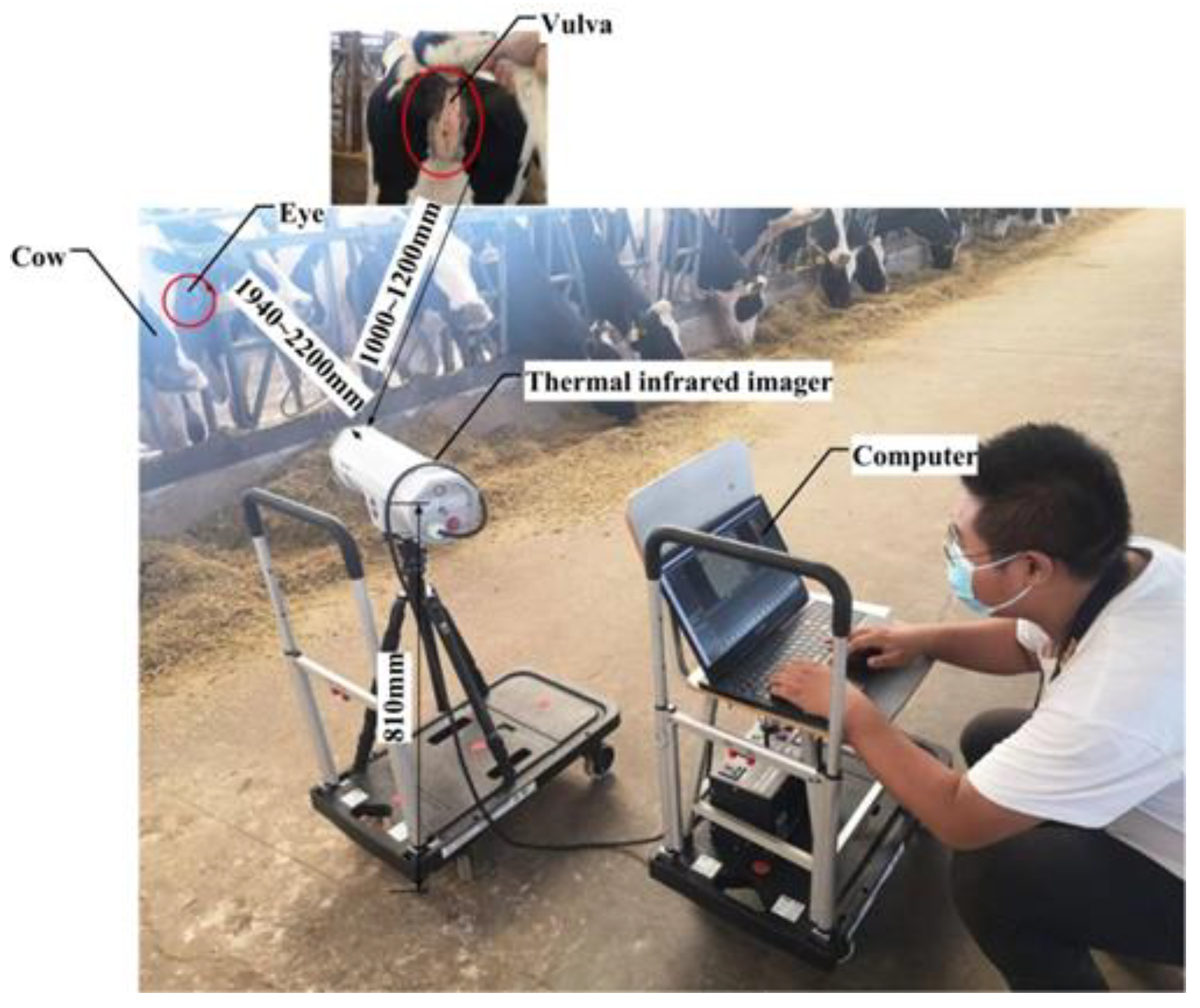
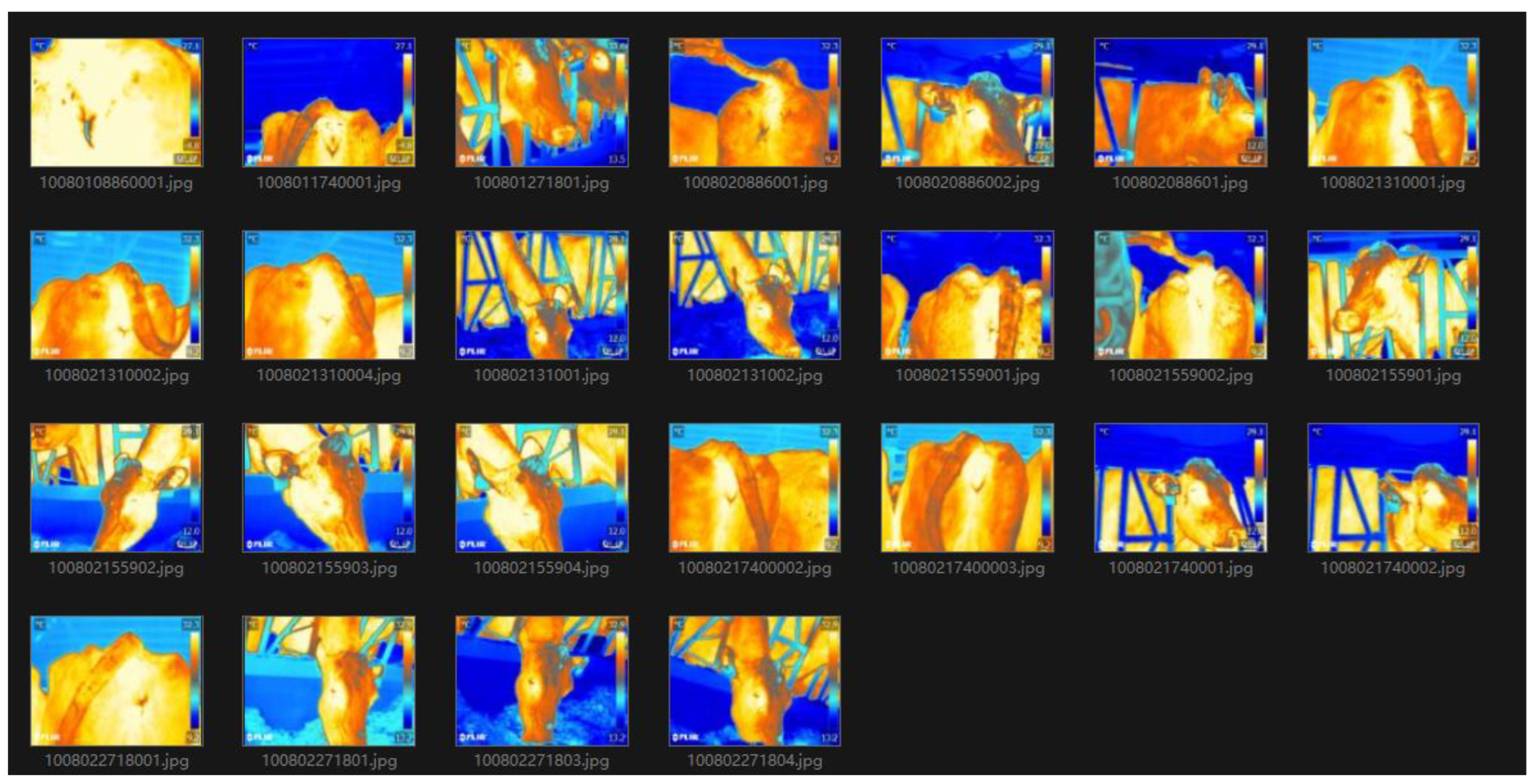
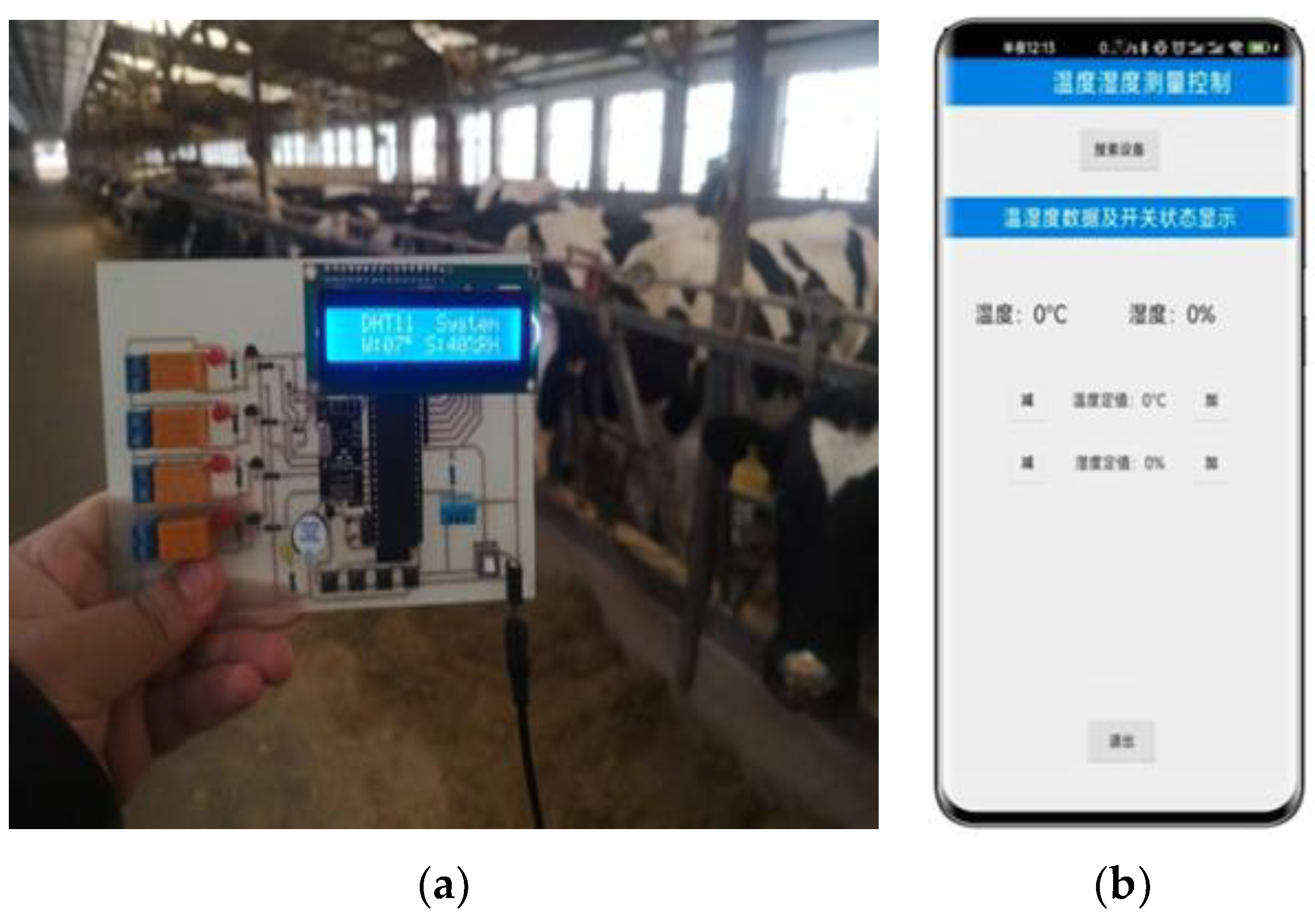
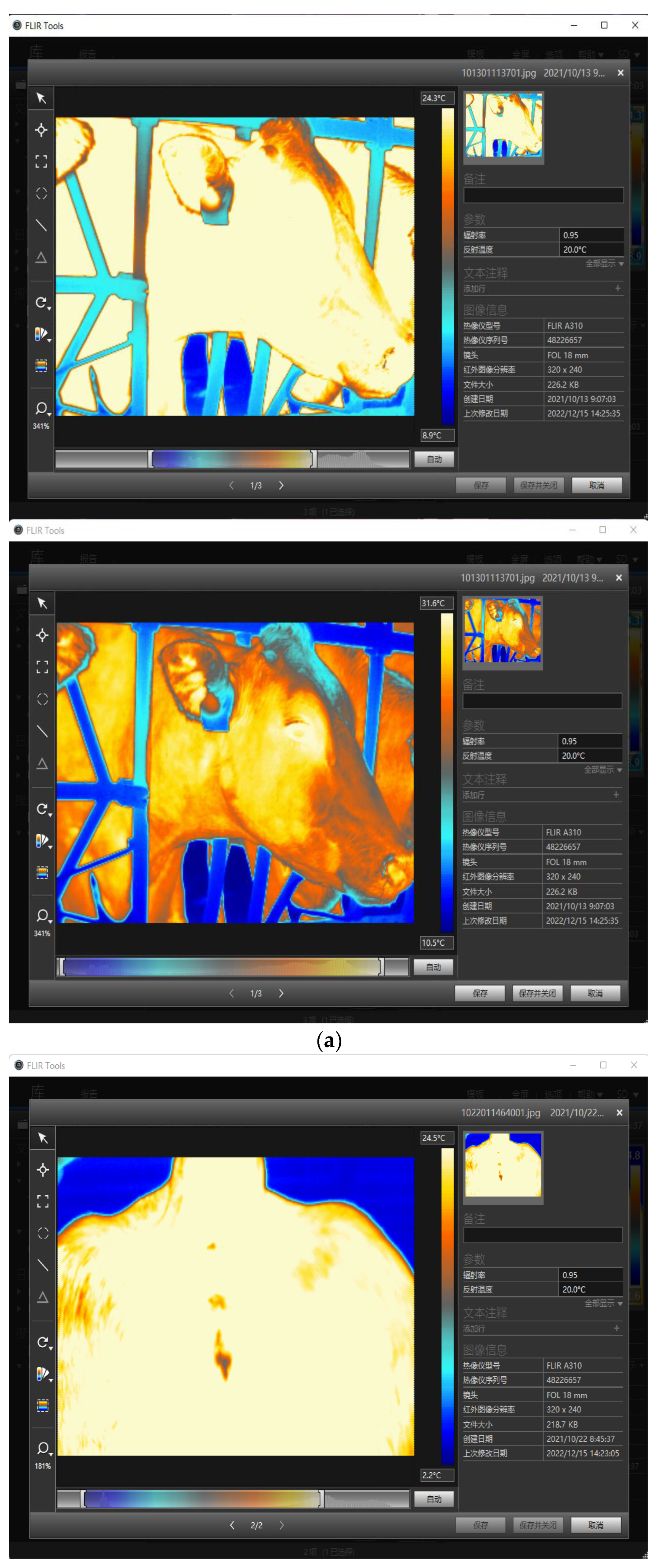
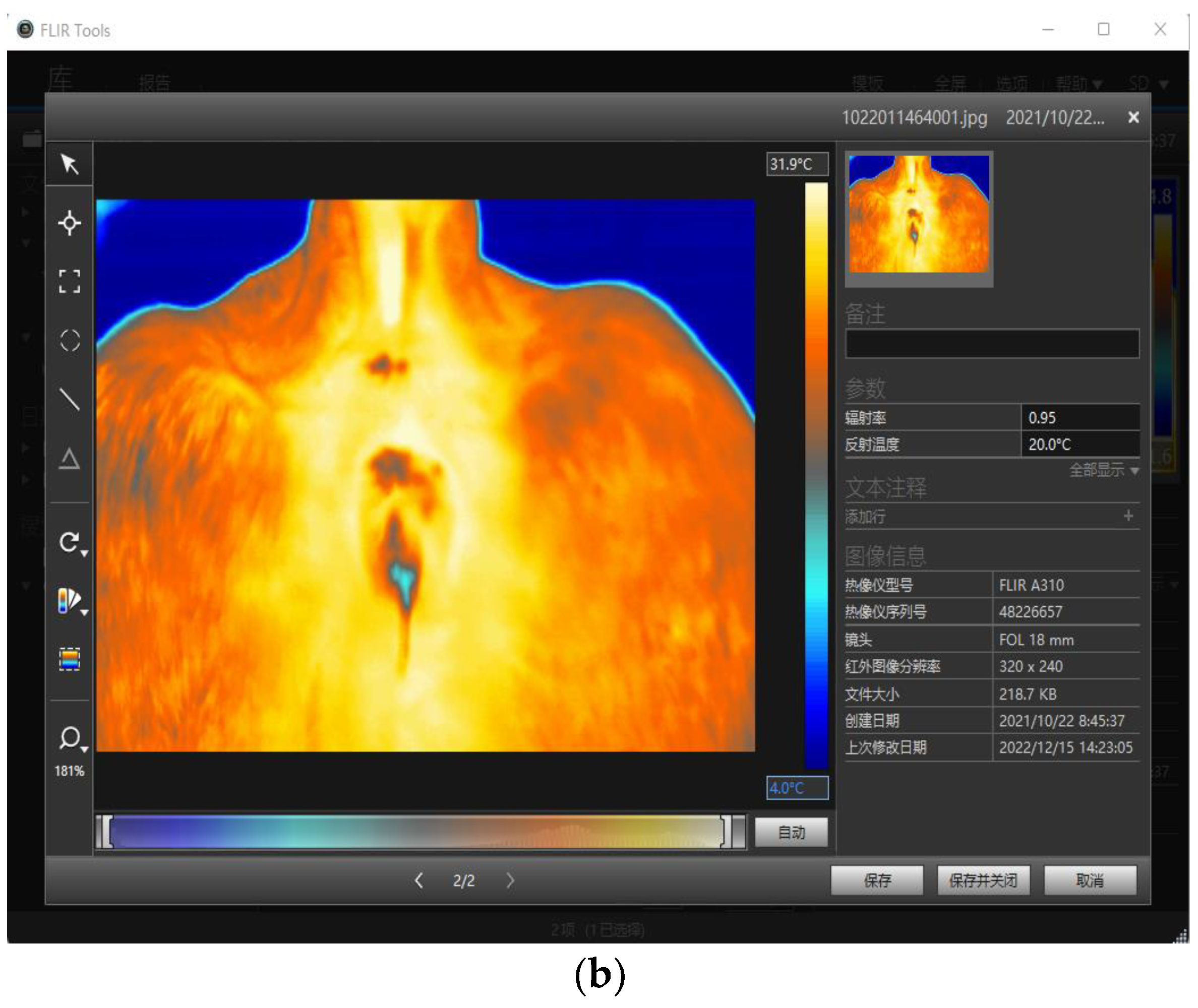
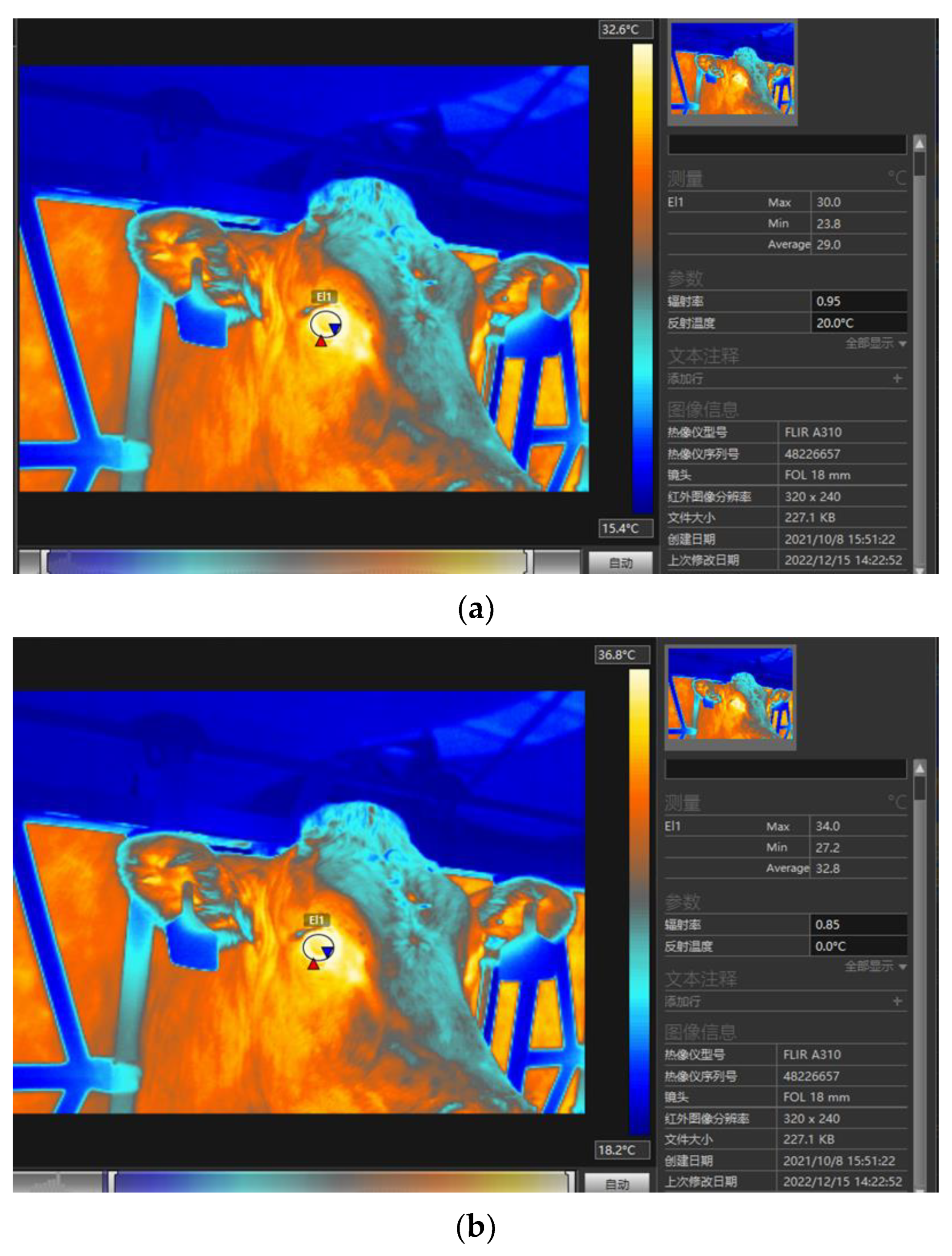
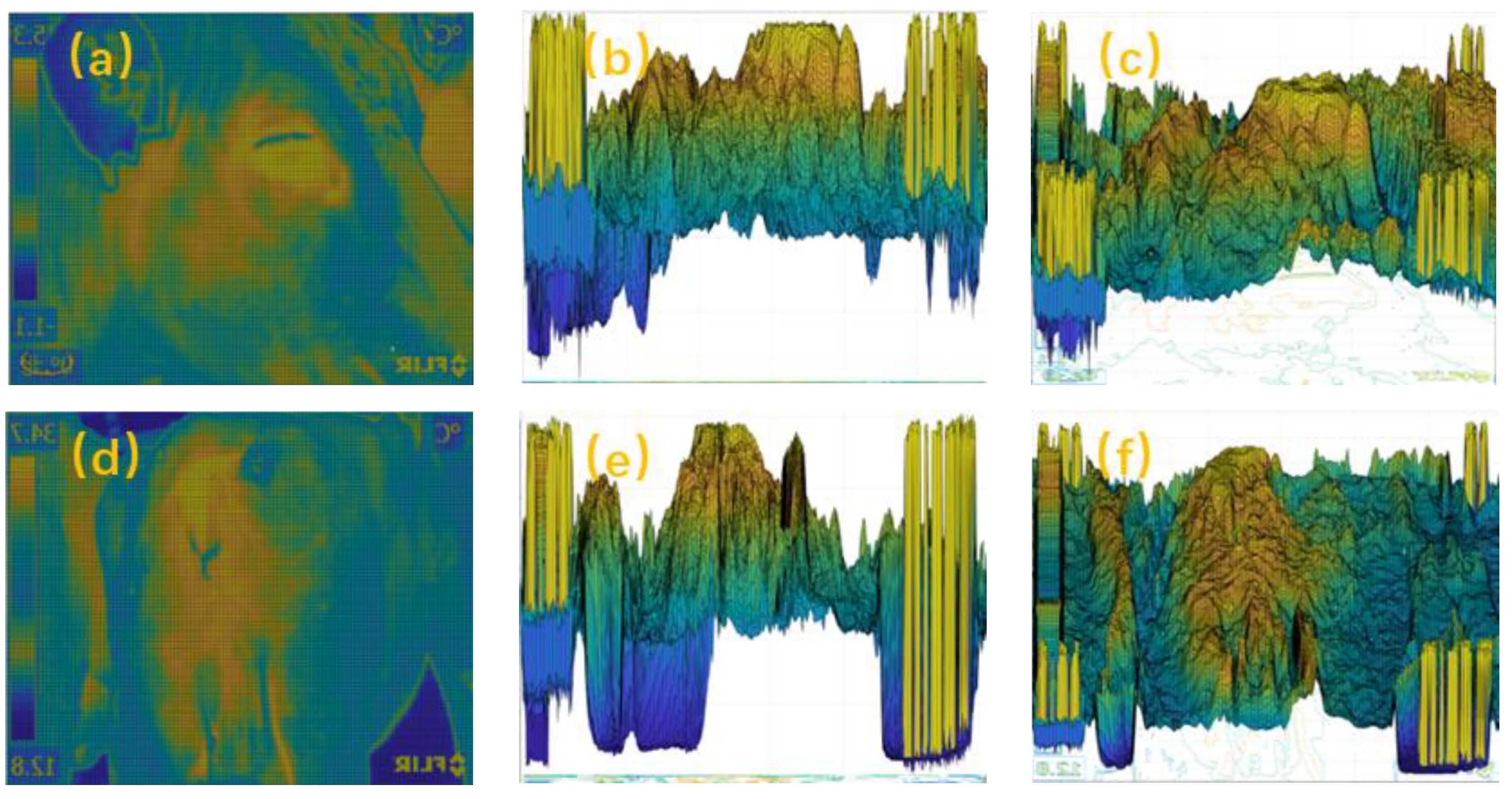
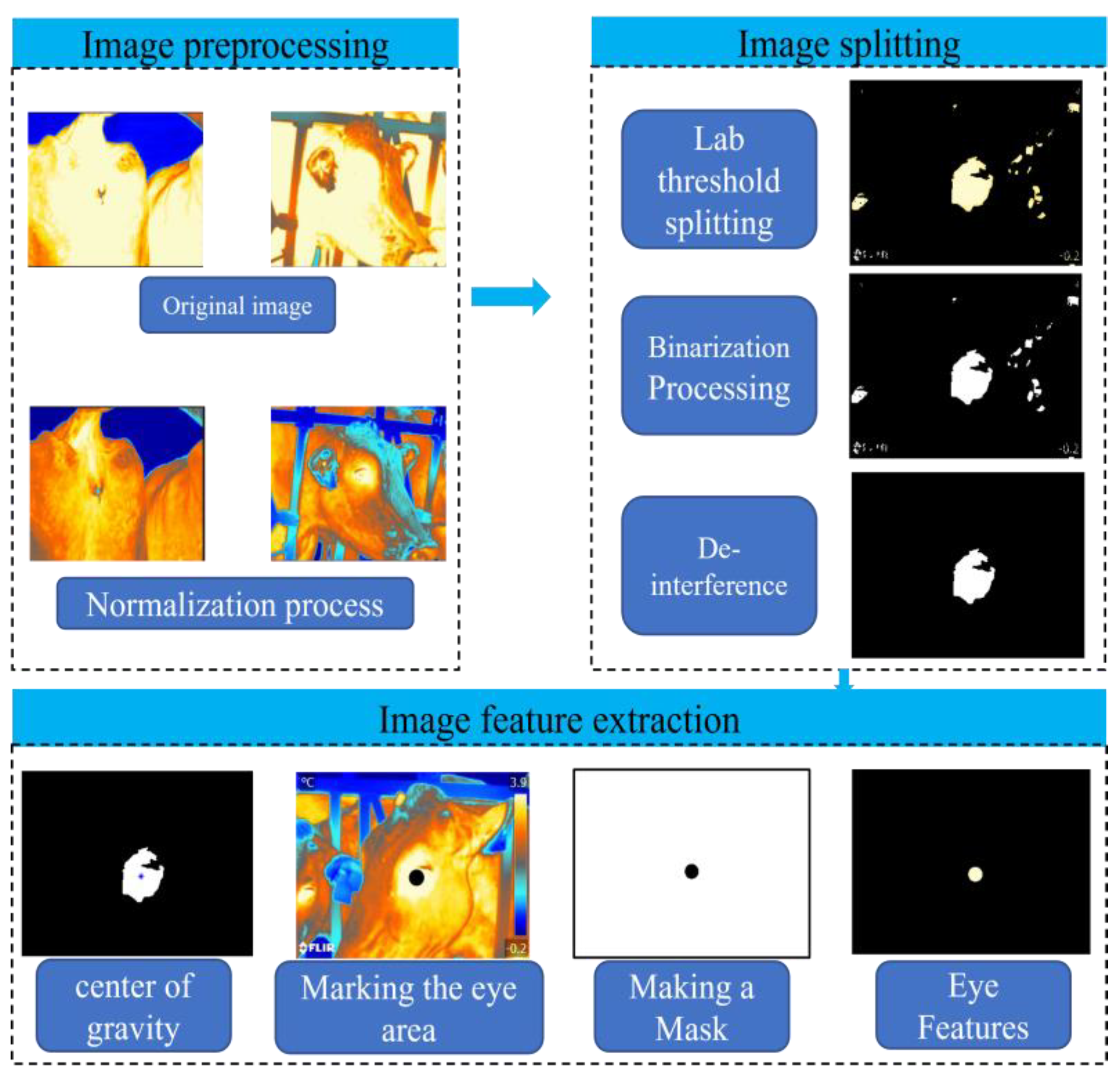

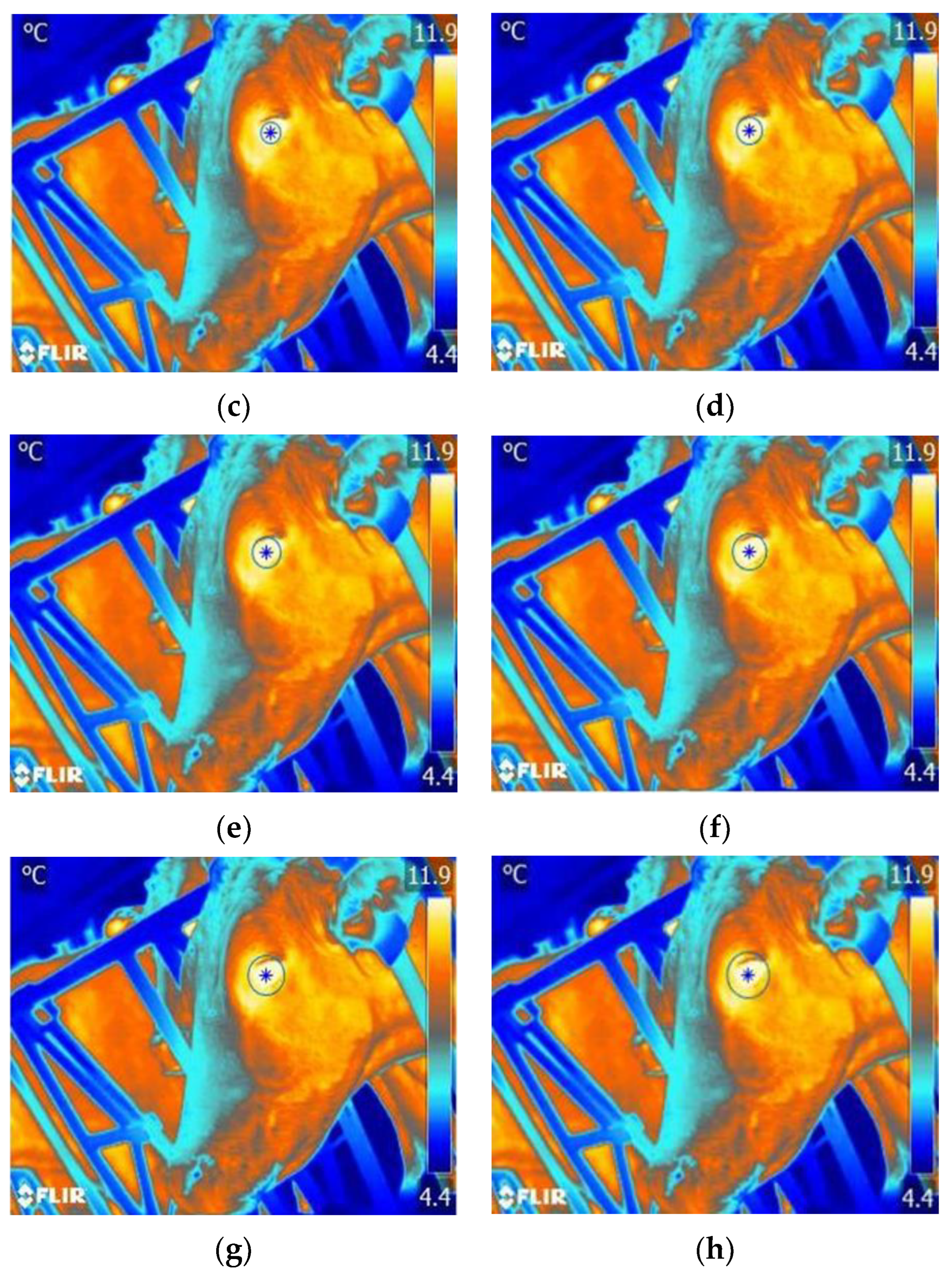
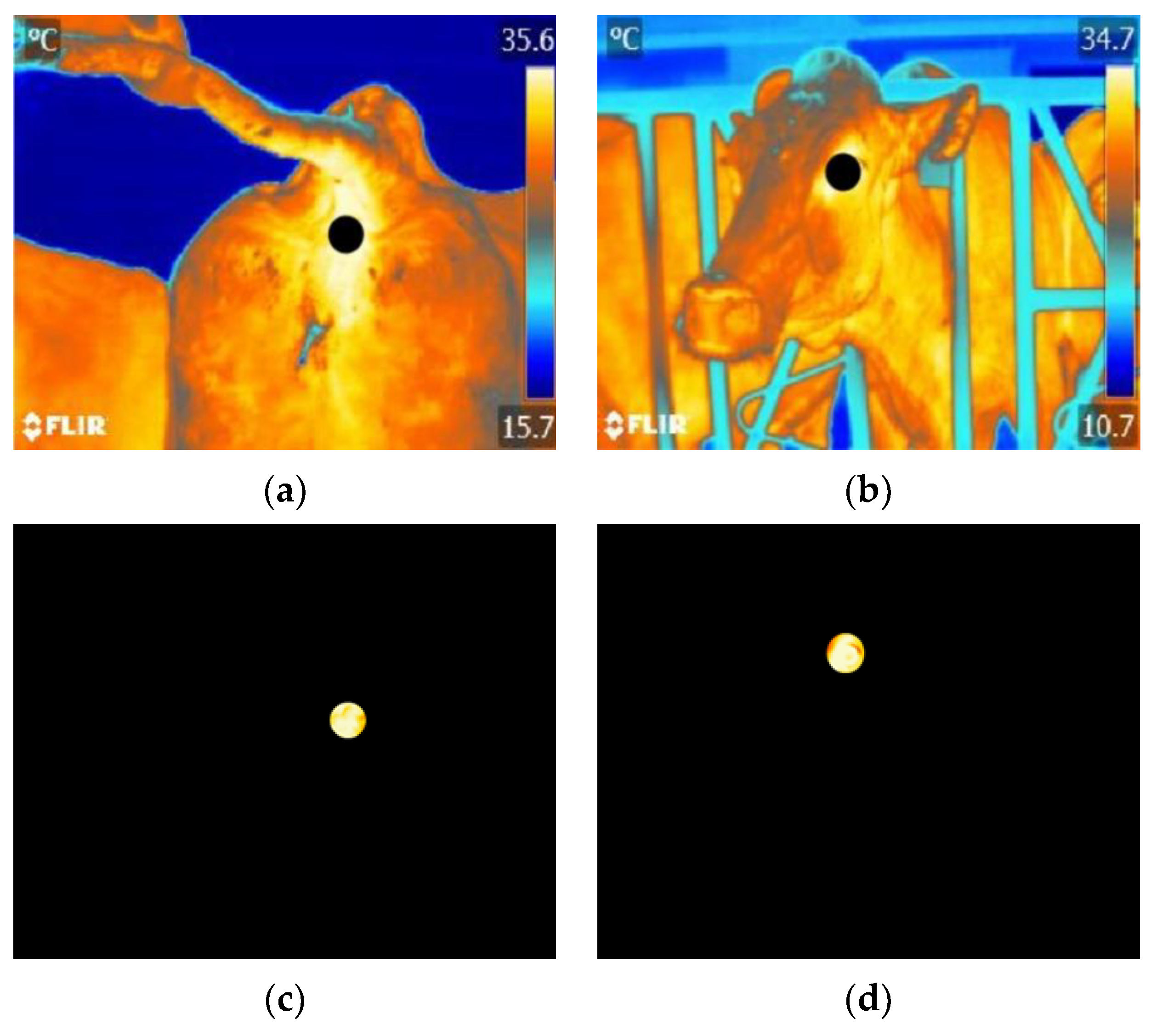
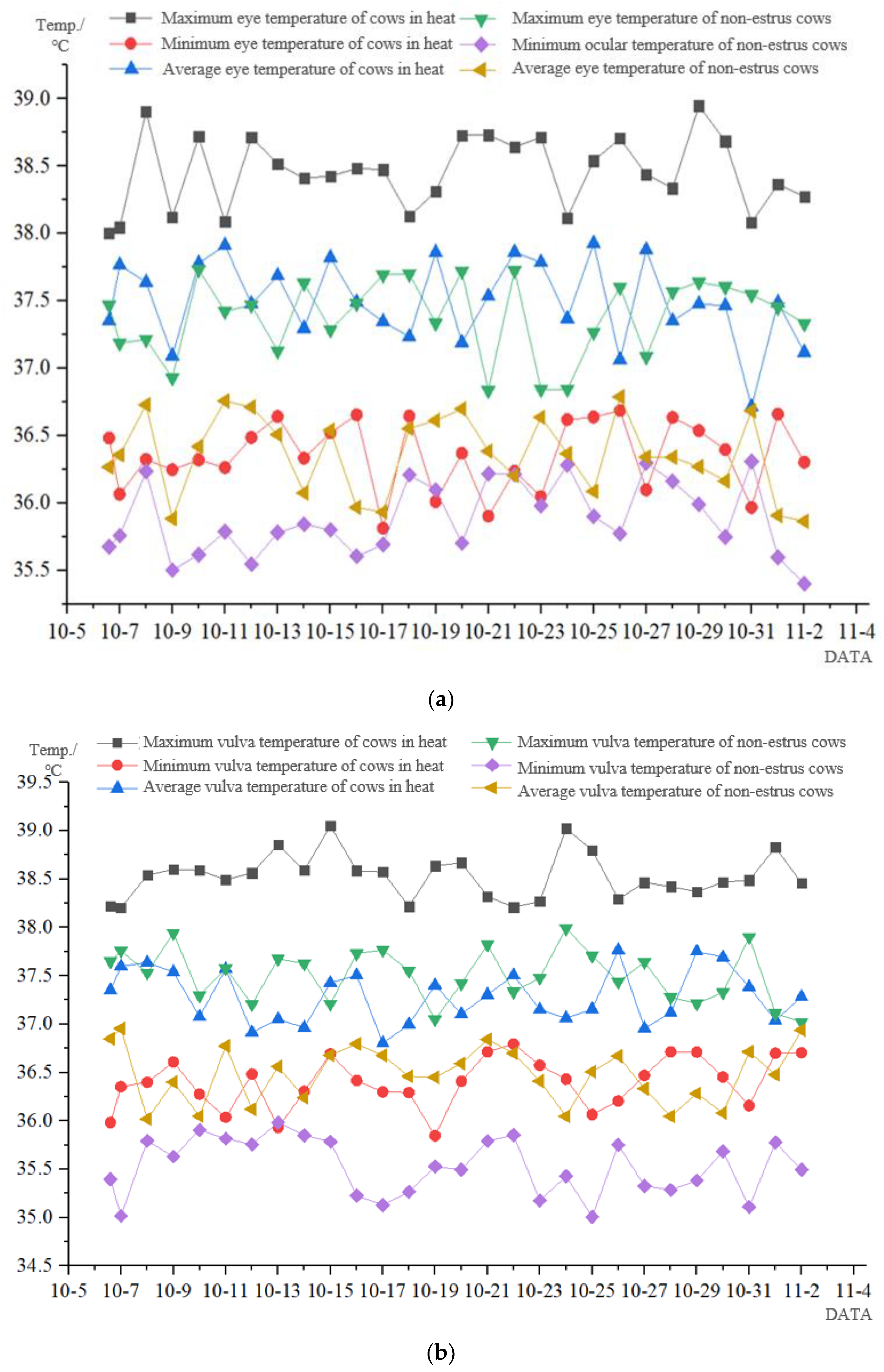
| MODEL | Index | INPUT | |
|---|---|---|---|
| Maximum, Minimum and Average Eye and Vulva Temperatures | Ocular and Vulval Maximum Temperature | ||
| LOGISTIC | Error rate/% | 18.30 | 15.00 |
| Recall/% | 87.25 | 89.40 | |
| SVM | Error rate/% | 18.70 | 16.60 |
| Recall/% | 86.94 | 88.75 | |
| r | Eye of Cows not in Heat | Eye of Cows in Heat | ||||
|---|---|---|---|---|---|---|
| Maximum Temperature | Minimum Temperature | Average Temperature | Maximum Temperature | Minimum Temperature | Average Temperature | |
| 0 | 37.2 | 37.2 | 37.2 | 38.4 | 38.4 | 38.4 |
| 5 | 37.2 | 36.5 | 36.8 | 38.4 | 38.0 | 38.2 |
| 10 | 37.2 | 36.3 | 36.4 | 38.4 | 37.6 | 37.9 |
| 12 | 37.2 | 36.0 | 36.4 | 38.4 | 37.4 | 37.9 |
| 14 | 37.2 | 29.4 | 32.7 | 38.4 | 30.4 | 33.6 |
| 16 | 37.2 | 20.4 | 32.2 | 38.4 | 25.6 | 32.9 |
| 18 | 37.2 | 19.8 | 27.2 | 38.4 | 23.2 | 32.0 |
| 20 | 37.2 | 19.8 | 26.8 | 38.4 | 23.6 | 30.1 |
| r | Vulva of Anestrous Cows | Vulva of Estrous Cows | ||||
|---|---|---|---|---|---|---|
| Maximum Temperature | Minimum Temperature | Average Temperature | Maximum Temperature | Minimum Temperature | Average Temperature | |
| 0 | 37.4 | 37.4 | 37.4 | 38.8 | 38.8 | 38.8 |
| 5 | 37.4 | 37.0 | 37.2 | 38.8 | 37.9 | 38.0 |
| 10 | 37.4 | 36.9 | 37.0 | 38.8 | 37.5 | 37.8 |
| 12 | 37.4 | 36.6 | 36.8 | 38.8 | 37.0 | 37.2 |
| 14 | 37.4 | 27.2 | 30.4 | 38.8 | 30.7 | 32.4 |
| 16 | 37.4 | 22.8 | 27.8 | 38.8 | 26.1 | 31.2 |
| 18 | 37.4 | 20.2 | 26.6 | 38.8 | 25.8 | 29.0 |
| 20 | 37.4 | 19.4 | 25.4 | 38.8 | 24.9 | 27.4 |
| r | Eyes of Anestrous Cows | Vulva of Estrous Cows | ||||
|---|---|---|---|---|---|---|
| Maximum Temperature | Minimum Temperature | Average Temperature | Maximum Temperature | Minimum Temperature | Average Temperature | |
| 12.0 | 38.4 | 37.4 | 37.9 | 38.8 | 37.0 | 37.2 |
| 12.5 | 38.4 | 36.2 | 36.8 | 38.8 | 36.4 | 36.9 |
| 13.0 | 38.4 | 35.6 | 36.4 | 38.8 | 35.2 | 36.2 |
| 13.5 | 38.4 | 33.4 | 35.8 | 38.8 | 32.4 | 33.8 |
| 14.0 | 38.4 | 30.4 | 33.6 | 38.8 | 30.7 | 32.4 |
Disclaimer/Publisher’s Note: The statements, opinions and data contained in all publications are solely those of the individual author(s) and contributor(s) and not of MDPI and/or the editor(s). MDPI and/or the editor(s) disclaim responsibility for any injury to people or property resulting from any ideas, methods, instructions or products referred to in the content. |
© 2023 by the authors. Licensee MDPI, Basel, Switzerland. This article is an open access article distributed under the terms and conditions of the Creative Commons Attribution (CC BY) license (https://creativecommons.org/licenses/by/4.0/).
Share and Cite
Wang, Z.; Wang, S.; Wang, C.; Zhang, Y.; Zong, Z.; Wang, H.; Su, L.; Du, Y. A Non-Contact Cow Estrus Monitoring Method Based on the Thermal Infrared Images of Cows. Agriculture 2023, 13, 385. https://doi.org/10.3390/agriculture13020385
Wang Z, Wang S, Wang C, Zhang Y, Zong Z, Wang H, Su L, Du Y. A Non-Contact Cow Estrus Monitoring Method Based on the Thermal Infrared Images of Cows. Agriculture. 2023; 13(2):385. https://doi.org/10.3390/agriculture13020385
Chicago/Turabian StyleWang, Zhen, Shuai Wang, Chunguang Wang, Yong Zhang, Zheying Zong, Haichao Wang, Lide Su, and Yingjie Du. 2023. "A Non-Contact Cow Estrus Monitoring Method Based on the Thermal Infrared Images of Cows" Agriculture 13, no. 2: 385. https://doi.org/10.3390/agriculture13020385
APA StyleWang, Z., Wang, S., Wang, C., Zhang, Y., Zong, Z., Wang, H., Su, L., & Du, Y. (2023). A Non-Contact Cow Estrus Monitoring Method Based on the Thermal Infrared Images of Cows. Agriculture, 13(2), 385. https://doi.org/10.3390/agriculture13020385





